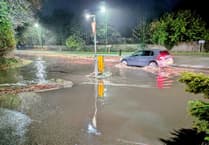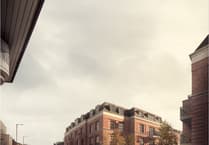The floods caused widespread damage across the town after hours of torrential rain caused the River Wey to overflow.
It was reported that large areas were covered with deep water, of which Bridge Square, Abbey Street, Red Lion Lane, Longbridge, Downing Street, the Church Lanes, Old Vicarage Lane, Union Road and South Street were all badly affected. Gostrey Meadow was described as “a lake”, as was most of Borelli Walk.
The front page story added that “parts of Wrecclesham near the river, The Hatches, and the eastern approaches right through to Waverley and beyond were all involved, and the meadows up the valley looked like an inland sea”.
Rescuers went out in rowing boats and canoes, and paddled through the water-filled streets to help those who needed it.
It was reported that at one home police and members of Farnham Hedgehogs had to wade through waist deep water to get to a blind lady who was upstairs “listening happily to the radio”.
Policemen, Farnham Urban Council employees and army personnel from Aldershot and Bordon worked together to minimise danger and evacuate residents of flooded homes.
It was later reported that one canoe was “smashed in half during the flood”, and that a colleague “grabbed Pc Roger Wade as he was flung from the canoe into surging water which was waist-deep”.
A policeman said at the time: “We really had to hang on to him or he would have been swept away.”
Farnham Police Station was “virtually an island”, so a temporary dry station was set up at the former Vick Bros. Garage on Firgrove Hill.
Despite being “inundated with emergency calls”, police managed to deal with a lost dog enquiry, investigate the disappearance of a tent and bed at Ash Vale belonging to “a gentleman of the road”, rescue people trapped in a submerged car in Runwick Lane, guide four frightened horses to safety from a flooded field at Badshot Lea, visit isolated homes and supervise traffic movement.
“Policemen were everywhere, many of them were on duty continuously from 6.30 Sunday morning until Monday night,” the report added.
It was also reported that the fire service “pumped water from cellars and basements for 15 and a half hours non-stop”.
A Flood Emergency Fund was subsequently set up by the Farnham Urban District Council chairman, Mr RF Cordier, at a special council meeting.
In an appeal notice published in the Herald, Mr Cordier said: “This flooding spread over a wider area than ever before, when not only did the River Wey break its banks and cover the lower part of the town centre, but the Bourne Stream became a raging torrent and left a trail of damage and destruction along its entire length within the urban district.
“Many houses had water in them to a depth of several feet causing extensive damage to decorations, furniture, carpets, etc., and the repair or replacement of these items is going to place a heavy financial burden on those who suffered in the flood.
“I have, therefore, decided to open a Flood Emergency Fund so that some financial help can be given to those in need.
“I do hope that residents in Farnham will respond generously to help their fellow townspeople in distress.”
In the following week’s edition of the Farnham Herald (September 27, 1968), it was reported that the amount raised “stood at £977 by midday yesterday (Thursday)” and that financial help had already been given “to some of those who suffered severely”.
One of the paper’s then readers, Mrs MR Alexander, also made the suggestion “that each resident in the town who can afford it should contribute £1 to the fund”, covering the flood damage and potentially “leaving a margin in hand for any future cases of hardship”. She preceded to give a “practical expression to her opinion by forwarding through us a donation of £1”.
During the previously mentioned special council meeting, deputy surveyor, Mr NP Youldon, gave details of the affected areas. It was reported that “in the 24 hours up to 9am on Sunday, 1.04 inches of rain were recorded at the sewage disposal works”, and then “up to midnight on Sunday a further 3.13 inches fell, making a total of 4.17 inches of more or less continuous rain”.
It was also estimated that between 50 and 100 private dwellings were “involved in financial loss”, of which a large number were not covered by private insurance.





Comments
This article has no comments yet. Be the first to leave a comment.